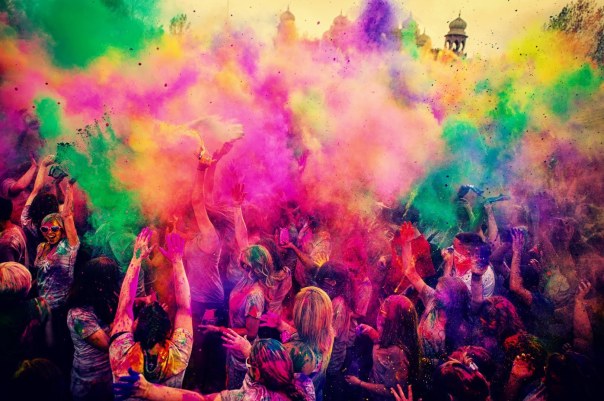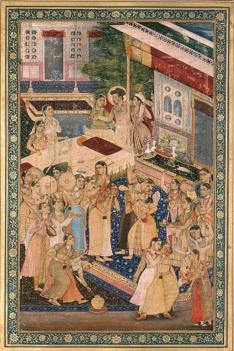Article: Holi and Muslims of the Indian Subcontinent
Posted by aaghazedosti
by Ravi Nitesh
https://aaghazedosti.wordpress.com/2017/03/13/holi-and-muslims/
Holi, a festival of colours has lots of stories around its origin but at the same time, the very nature of this festival has a philosophical note attached to it and that is ‘losing one’s identity’. Colours applied in Holi are from a vast range of colours and speaks of the importance of diversity; applying these colours involve ‘colouring everyone’ and doing so, it denotes equality and equal identity. In the color smeared face, the identity, the divisiveness of it, is also lost.
The Indian subcontinent, as a diverse space and with a history of its ‘cultural absorbency’ has brought Holi in different contexts and it is its beauty that despite being called as a Hindu festival by many, it has history tracings among Muslims as well where the context of Holi was specially brought. With its beauty of diversity, our society has brought many beautiful examples of cultural harmony and intermingling. Holi is one such festival that spreads and celebrates universal brotherhood.
In the stories of Holi, it is attached with the ‘Bhakt Prahlad’ story as a festival of victory of Good over Evil and then in another one with Krishna-Radha, it becomes a festival of love. Mughals in India, as we know, adopted many traditions and started many new. Holi was one festival, tradition that was beautifully adopted by Mughal Emperors and Sufi saints.
In the reign of Emperor Jahangir, Holi is called Holi as ‘Eid-e-Gulabi’ or ‘Aab-e-Pashi’ and he even played it with his queen. The Tuzuk-i-Jahangiri talks about this Holi festival.
In the reign of Jahangir, it is also called Holi as ‘Eid-e-Gulabi’ or ‘Aab-e-Pashi’ and he even played it with his queen. In Tuzuk e Jahangir, he has written about Holi festival.
‘Hori Khelungi, Keh Bismillah’ was a poem by Bulleshah, a 16th century poet. He has written in this poem about his desire to loose himself in God. Syed Abdullah Shah Qadri or Bulleshah lived in 17th century in places like Multan and Kasur that falls in present day Pakistan. Bulleshah was a humanist and philosopher and has written poetry on many subjects including social issues. His poetry have been sung by renowned singers of modern time including Nusrat Fateh Ali Khan, Abida Parveen, Wadali Brothers and others. In his Holi poem, he expressed ‘nam nabi ki ratn chadhi. Boond pari allah alaah’
Verses of Bahadur Shah Zafar (Last Mughal emperor of India) has been adopted very commonly by people. It says ‘Kyo mo pe rang ki maaari pichkari, Dekho kunwar ji doongi main gaari’ (Why you sprayed color on me, Now my prince, I will swear you). It is told that during his reign, special arrangements were made to celebrate holi and groups of people singing Holi songs and making jokes were allowed. On this day, making fun even on the cost of princess of princesses and it was not a punishable act that time. Spray of colorful and scented yellow flowers and sprayed through syringes of wood and metals.
Amir Khusro’s love with ‘Aaj rang hai’ is known to many people when he sung this song for his peer Auliya. Khusro was a 13thcentury poet, Sufi musician and scholar and spiritual disciple of Nizamuddin Auliya. Khusro is known as ‘Father of Indian Qawali’ and also has the credit for the invention of musical instruments like Sitar and Tabla. Khusro expressed in another verse ‘Kheloongo holi, Khawaja ji aaye’.
The Nawabs of Lucknow celebrated Holi as a festival of everyone. Wajid Ali Shah, the last nawab of Awadh has written ‘More kanha jo aaye palat ke, Abki holi mai khelungi dat ke’. Wajid Ali Shah also distributed sweets and thandai (a special Holi drink) to everyone in their kingdom.
Even ‘Holi khelein Asaf ud daula Wazir’ is one of the famous lines of renowned poet Meer and has talked about Nawab Asaf ud daula of Lucknow. Meer writes further ‘kumkum jo maarte bharkar gulal, jiske lagta aan kar phir mehendi laal’. Asaf-ud-Daula was nawab of Awadh in 18thcentury and is known as the architect general of Lucknow. He shifted the capital of Awadh from Faizabad to Lucknow and built famous structures like Bara Imaambara and Rumi Darwaza. One of his very famous work includes construction of Asafi Imambara as a charity project in 1784 to generate employment after a famine. It included more than 20,000 people in construction of a structure that was neither a mosque nor mausoleum. It was also told that to protect dignity of noble and upper class (as they were also affected in famine), common citizens were employed to construct building in daytime and noble and upper class people were employed to demolish the structure on every fourth night. They all received payments for their work. There is still a famous saying ‘Jisko na dein maula, usko dein Asaf-ud-Daula’ means one who does not receive from Lord, will receive from Asaf-ud-Daula.
Abida Parveen, renowned Pakistani Sufi Singer, beautifully sung verses of the Sufi poet Shah Niaz where the poet says ‘Holi ho rahi hai Ahmed jiya ke dwaar, Hazart ali ka rang bano hai Hasaan Hussain Khilar’ (Holi is happening at beloved Ahmed’s door, Color has become Hazrat Ali and Hasan and Hussain are playing.’
It is also said that even today’s old Lucknow chowk area witness the ‘Holi Baraat’ jointly by Hindus and Muslims that runs along Muslim dominant areas and receive showers of flowers and colours.
Holi was not just restricted to Nawabs and Emperors, it also went to writings of many poets. Even freedom fighter and poet Hasrat Mohani writes ‘Mohe chhed karat nandlal, Liye khade abeer gulal’.
Even Nawabs of Bengal like Murshid Quli Khan Alivardi, Siraj-ud-Daula and Mir Jafar celebrated holi as well. The shrine of Haji Waris Ali Shah in Deva Sharif observe Holi even in today’s India.
If we say that this is the society we hail from, we desire and we contribute for, what can be more beautiful than this!
Photo Sources:
Holi Celebration
Holi and Jahangir
Holi and Bahadur Zafar
Advertisements



